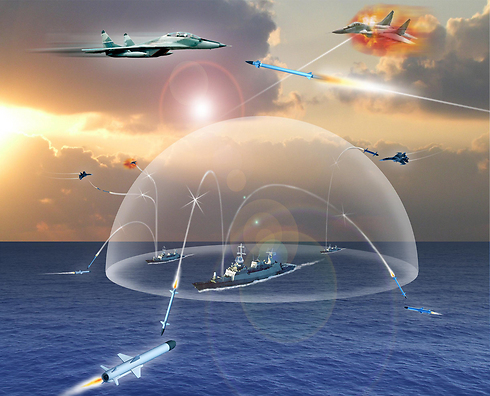
 WATCH TEST: The Israel Aerospace Industries long range surface-to-air Barak 8 missile system, jointly developed with India, is said to have cost $1.4 billion to develop, can intercept and eliminate aerial threats at extended ranges.
WATCH TEST: The Israel Aerospace Industries long range surface-to-air Barak 8 missile system, jointly developed with India, is said to have cost $1.4 billion to develop, can intercept and eliminate aerial threats at extended ranges.
By Yoav Zitun, Reuters
India successfully test-fired on Wednesday the Barak 8, a new long range surface-to-air missile capable of countering aerial threats at extended ranges, which was jointly developed with Israel.

The Israeli Navy testing the Barak 8 system last month
The Israel Aerospace Industries, which held a successful test of the Barak 8 missile last month, said that the two tests held by the Indian Navy on Tuesday night and Wednesday morning complete a series of three consecutive tests which “reinforces the impressive operational capabilities of the system,” said IAI director Yossi Weiss.
IAI officials said the successful tests show that the Barak 8 is ready for delivery to the buyers, including the Indian Air Force.
The tests in India significantly advanced the development of the land version of Barak 8 which, much like the Iron Dome, will also be mobile and deployed with radars and launchers mounted on trucks or naval vessels.

The Barak 8 system comes in both land and sea versions – Photo: IAI
The test-firing of the missile system was carried out by warship INS Kolkata, a much larger ship than those used by the Israeli Navy, which required compatibility changes to be made to the systems.
The aerial defense system includes a radar for detection, tracking and missile guidance. Defense industry officials told Reuters last year that the value of the Barak 8 project was $1.4 billion.
“In the India tests, the Barak missile’s radar-based sensor identified the target throughout its entire flight, until hitting it with its warhead with fantastic accuracy,” a senior IAI official told Ynet.
Barak 8 was developed to counter Hezbollah’s advanced missiles, including the Yakhont missile (the P-800 Oniks). It is capable of identifying from aerial threats from a distance, like drones, fighter jets, missiles and rockets – even if several such threats are launched at the same time.
The Adir radar system, developed by the IAI, will operate alongside the Barak 8. It can spot threats from greater distances, mark more targets at the same time, and identify enemy battle ships hiding in the midst of dozens of civilian vessels. The Adir system will gather intelligence of higher quality from far out at sea – thousands of kilometers away from Israel.
The radar system digitally “stares” at the area it is covering using four plates installed at the top part of the deck.

Israeli multi layered defense system – Photo: IAI
Only a small club of countries including the United States, France, Britain and Israel possess such capability, a Defense Research and Development Organization spokesman said.
Israel is one of India’s top three arms suppliers, delivering items such as missiles and unmanned aerial vehicles, but such transactions were long largely unpublished because of India’s fear of upsetting Arab countries and its own large Muslim population.
India, which shares borders with nuclear-armed China and Pakistan, is likely to spend $250 billion over the next decade to upgrade its military.
It is the world’s biggest buyer of defense equipment, but Prime Minister Narendra Modi is trying to build a defense industrial base in the country to cut overseas purchases.
View original Ynet publication at:
http://www.ynetnews.com/articles/0,7340,L-4746305,00.html






 Israeli New Shekel Exchange Rate
Israeli New Shekel Exchange Rate